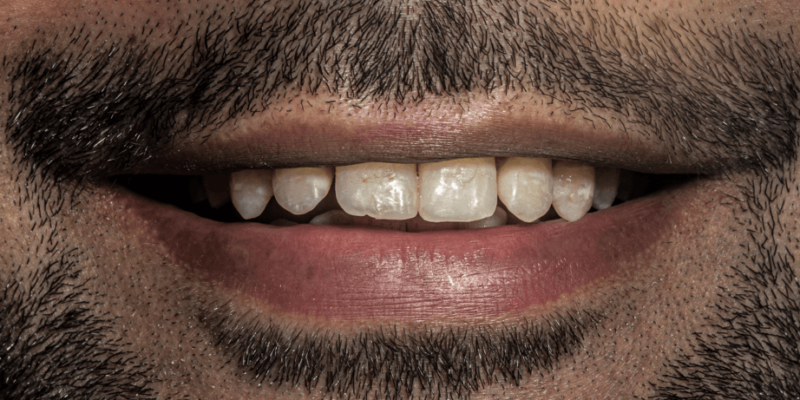– Dr. Ridyumna Garain is the winner at 3rd position, jury special mention award for DR Pronto Esthetic Challenge 1, 2021-2022
Introduction
Discrepancy of tooth shape or size and inappropriate distribution of space between the anterior teeth is a major esthetic concern for patients.1 Proximally bonded direct composite resins are a practical and conservative treatment option for space closure. 2,3 Direct composite restorations have several distinct advantages. They permit conservation of tooth structure, reversibility of procedure, relative ease of addition or removal of materials as necessary, along with being economical for the patient.
The esthetic appearance of teeth forms a part of an overall picture, interacting closely with facial esthetics. Since a pleasant smile is governed largely by symmetry, asymmetry of shape and size creates an unacceptable esthetic presentation.
This case report details the esthetic rehabilitation of maxillary anterior teeth with interdental spacing. In the present case, the patient’s esthetic expectations were met successfully through comprehensive digital treatment planning and direct composite restorations. 4
Case Report
A 23-year-old male patient reported to the clinic with a complaint of spaces between his upper front teeth. He gave a history of having undergone orthodontic treatment previously.
Clinical Findings
Clinical examination revealed spacing between teeth 11 and 12, 22 and 23, 23 and 24, 21 and 22, 22 and 23, and 23 and 24. A faulty class IV restoration was noted with respect to mesioincisal aspect of 11. Residual composite after debonding of brackets was also noted on all the teeth. A Class II molar relation with large overjet and deep bite was also noted.
Figures 1-3 show the extra-oral and figures 4-6 show the intra-oral pre-operative status of the patient respectively.



Figure 1-3: Pre-operative Extra-oral Pictures



Figure 4-6: Pre-operative Intra-oral Pictures
Treatment Plan
The patient was provided with various treatment options. However, the patient desired a quick and minimally invasive treatment option. Hence, it was decided to carry out direct composite build up from canine to canine to close the spaces, using digital planning, diagnostic mockup and a silicon index.
Treatment
In the first visit, reference photographs were taken. Space closure was planned digitally (Figure 7,8). 4 Esthetic tooth forms were created and areas for composite addition were identified. Following this, upper and lower diagnostic casts were made on which a wax build up was done. A silicon putty matrix was prepared from this.


Figure 7,8: Digital Planning
During the second visit, shade selection was carried out (Figure 9). Activa™ Pronto shade A4 was found to be a good match in the cervical region, and Activa™ Pronto shade A2 was found to be a good match in the middle and incisal regions.

Figure 9: Shade Selection
Since a "no-prep" approach was planned for closing the spaces between teeth, oral prophylaxis was carried out to eliminate the biofilm from the tooth surfaces. Following this, the previous class 4 restoration on 11 was removed. The residual composite on the labial surfaces of the teeth was also removed. The proximal surfaces of the teeth (canine to canine) were roughened (Coarse So-Flex discs). After this, under rubber dam isolation, the tooth surfaces were etched and bonded. The putty matrix was positioned, and the palatal and proximal walls were built.
The cervical region of the teeth were built up using Activa™ Pronto shade A4. The middle and incisal thirds were built up, according to the simple layering concept by layering Activa™ Pronto shade A2 on a base of Activa™ Pronto shade A3.5. This provided depth to the restoration.
Finishing and polishing was carried out (Shofu Composite finishing kit and So-Flex discs).
Figures 10-12 show the post-operative intra-oral and figures 13-15 show extra-oral results, respectively.



Figure 10-12: Post-operative Intra-oral Pictures



Figure 13-15: Post operative Extra-oral Pictures
Discussion
Direct composite restorations maybe preferable in cases where conservative, esthetic correction of the appearance of anterior teeth is indicated. However, extensive esthetic corrections demand an interdisciplinary approach. In the present case, the patient had previously undergone orthodontic treatment to correct malalignment of his teeth. The use of conservative direct composite resins for proximal build-ups and recontouring of tooth shape resulted in a symmetrical, esthetic, and harmonious appearance.
Conclusion
A comprehensive treatment plan along with conservative direct composite build-ups resulted in a successful outcome with patient's satisfaction, rather than simple closure with composite addition.
References
- Wolff D, Kraus T, Schach C, Pritsch M, Mente J, Staehle HJ, et al. Recontouring teeth and closing diastemas with direct composite buildups: a clinical evaluation of survival and quality parameters. J Dent [Internet]. 2010 Dec;38(12):1001–9.
- Kim Y-H, Cho Y-B. Diastema closure with direct composite: architectural gingival contouring. J Korean Acad Conserv Dent [Internet]. 2011 Nov 1;36(6):515–20.
- Báez Rosales A, De Nordenflycht Carvacho D, Schlieper Cacciutolo R, Gajardo Guineo M, Gandarillas Fuentes C. Conservative Approach for the Esthetic Management of Multiple Interdental Spaces: A Systematic Approach. J Esthet Restor Dent. 2015 Nov 1;27(6):344–54.
- McLaren EA, Culp L. Smile Analysis The Photoshop® Smile Design Technique: Part I. J Cosmet Dent. 2013;29(1):94–108.
- Manauta J, Salat A. Layers : an atlas of composite resin stratification. 2012;444.




















Comments